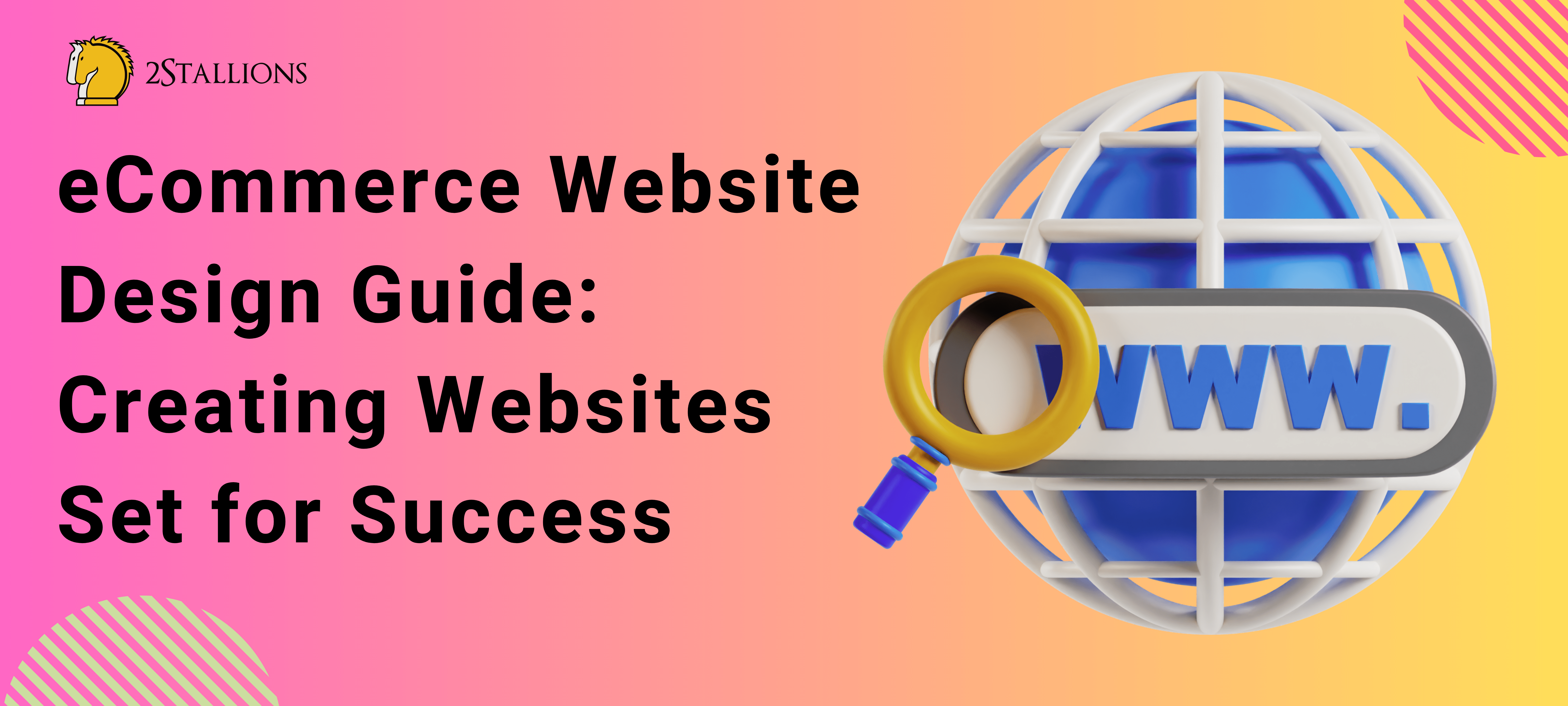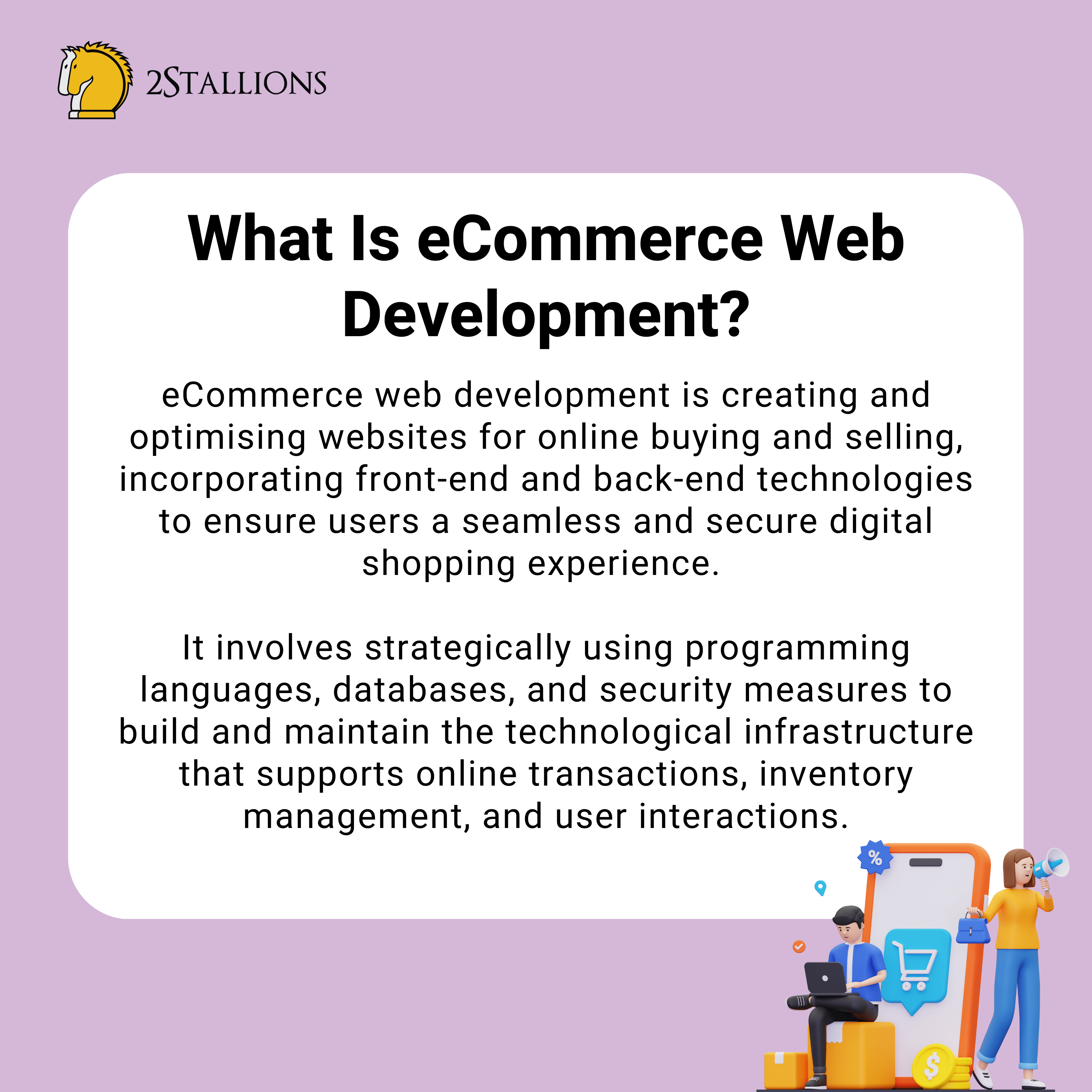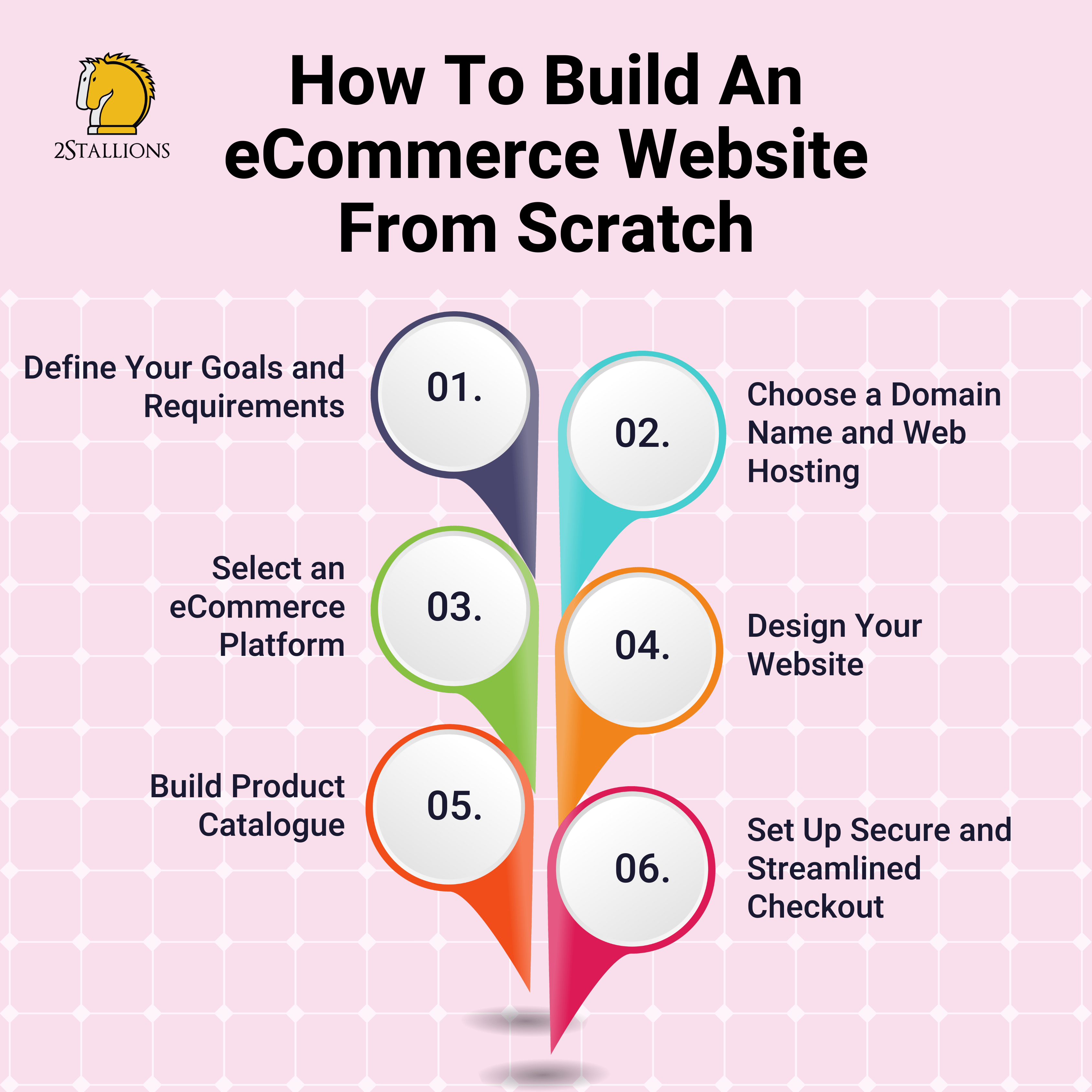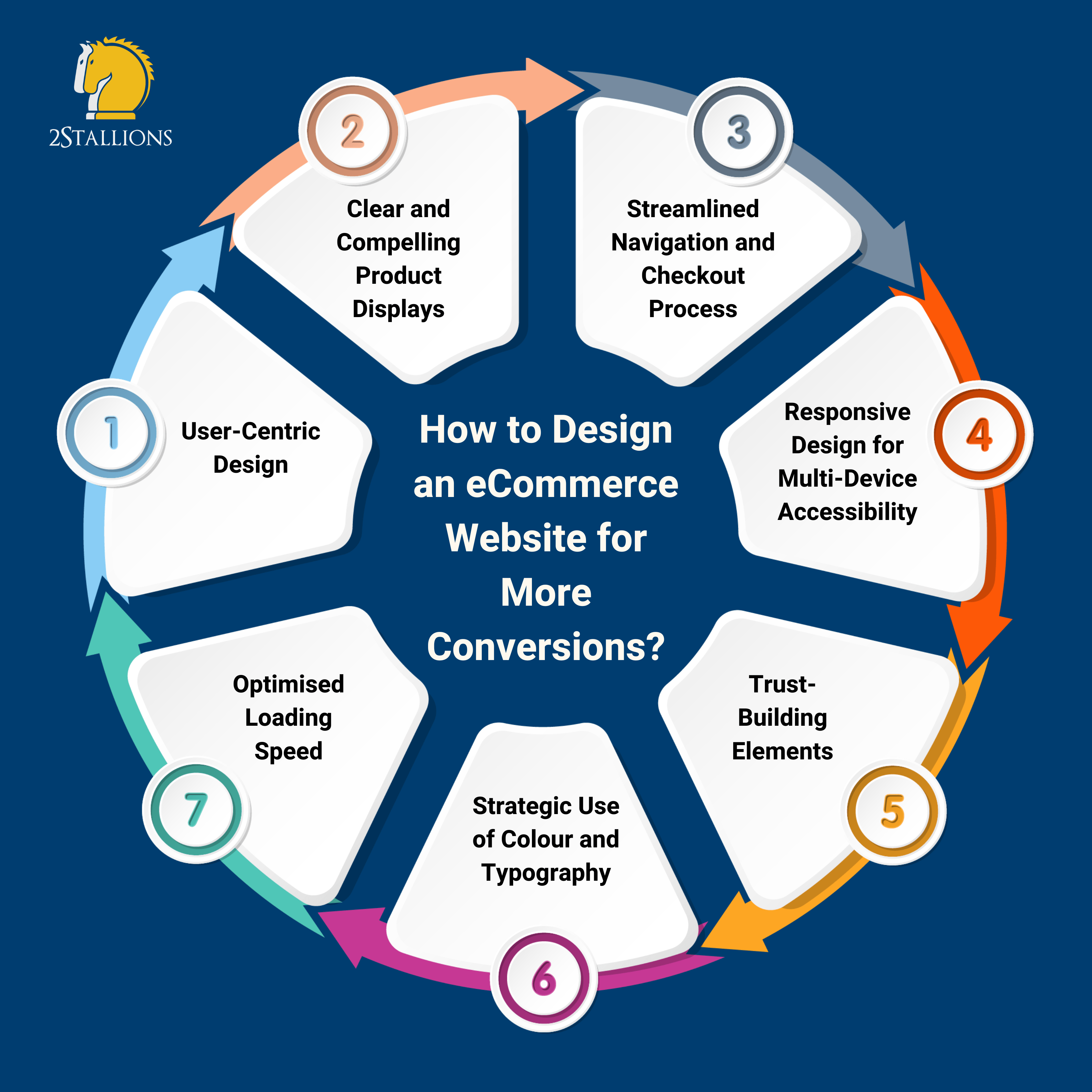SHARE

A well-designed and user-friendly eCommerce website is the cornerstone of success in the rapidly evolving landscape of online commerce. As businesses strive to carve their niche in the digital realm, understanding the intricacies of effective website design becomes paramount.
What Is eCommerce Web Development?
In the fast-paced world of online commerce, the backbone of a successful business often lies in the sophistication and functionality of its digital storefront. eCommerce web development is the intricate process of conceptualising, designing, and implementing the technological framework that enables businesses to operate and thrive in the digital marketplace.
At its essence, eCommerce web development involves creating and optimising websites tailored for buying and selling products or services over the internet. This multidisciplinary field encompasses a range of technologies, frameworks, and strategies to deliver a seamless and secure online shopping experience for customers while providing businesses with the tools they need to manage transactions, inventory, and customer interactions.
Key Components of eCommerce Web Development:
Front-End Development:
Front-end development focuses on a website’s visual and interactive elements that users directly engage with. This includes the user interface’s design, layout, and functionality, ensuring a smooth and intuitive experience for visitors.
Mastering HTML, JavaScript, and CSS is essential for any front-end developer. These skills help create visually engaging websites and improve user interactions. With these skills, you are more than equipped to grab these remote front-end developer opportunities.
Back-End Development:
The back-end of an eCommerce website comprises the server, database, and application logic that work together to process and manage data. Back-end development is responsible for the behind-the-scenes functionality, including order processing, inventory management, and user authentication.
Database Management:
Effective eCommerce web development relies on robust database management systems to organise and store vast amounts of product information, user data, and transaction history. This ensures quick and efficient retrieval of data when needed.
Security Protocols:
Security is a paramount concern in eCommerce web development. Implementing Secure Socket Layer (SSL) certificates, encryption protocols, and adherence to best practices in data protection are critical to safeguarding customer information and maintaining trust.
Payment Gateway Integration:
Facilitating secure online transactions is a fundamental aspect of eCommerce. Payment gateway integration ensures that customers can make purchases with various payment methods, such as credit cards, digital wallets, and other forms of online payments.
Content Management Systems (CMS):
Content management systems facilitate creating, modifying, and organising digital content on the website. This includes product descriptions, images, pricing, and promotional content.
Responsive Design:
With users accessing websites from various devices, responsive design is essential. eCommerce websites must adapt seamlessly to different screen sizes and resolutions to provide a consistent and user-friendly experience across desktops, tablets, and smartphones.
Scalability and Performance Optimisation:
As businesses grow, eCommerce websites must be designed to scale. Performance optimisation strategies, such as load balancing and caching, ensure the website can handle increased traffic and maintain responsiveness.
How To Build An eCommerce Website From Scratch
Embarking on the journey to build an eCommerce website from scratch is an exciting endeavour that requires careful planning and execution. Creating a unique and user-friendly online store has become essential for success as the digital marketplace evolves.
1. Define Your Goals and Requirements:
- Identify the purpose of your eCommerce site, your target audience, and the products or services you’ll be offering.
- Determine the key features and functionalities required for your online store.
2. Choose a Domain Name and Web Hosting:
- Select a unique and memorable domain name that reflects your brand.
- Choose a reliable web hosting provider that meets your website’s technical requirements and offers scalability.
3. Select an eCommerce Platform:
- Choose an eCommerce platform that aligns with your business needs and technical proficiency. Options include Shopify, WooCommerce, Magento, and others.
4. Design Your Website:
- Develop a user-friendly and visually appealing design for your eCommerce site.
- Create straightforward navigation and intuitive user interfaces to enhance the overall user experience.
5. Build Product Catalogue:
- Compile a comprehensive product catalogue with high-quality images, detailed descriptions, and categorisation.
- Implement features like product variants, discounts, and inventory tracking.
6. Set Up Secure and Streamlined Checkout:
- Integrate a secure and user-friendly checkout process with multiple payment options.
- Ensure the implementation of SSL certificates to protect customer data and build trust.
7. Optimise for Search Engines (SEO):
- Optimise product pages and content for search engines to improve visibility.
- Use relevant keywords, create descriptive meta tags, and generate a sitemap.
8. Test Across Devices and Browsers:
- Test your eCommerce website thoroughly on different devices and browsers to ensure compatibility.
- Identify and fix any issues related to responsiveness or functionality.
9. Secure Your Website:
- Implement security measures to protect customer data and maintain the integrity of your website.
- Regularly update software, plugins, and security protocols.
10. Launch Your Website:
- Once everything is set up and tested, launch your eCommerce website.
- Monitor the initial performance and address any issues promptly.
11. Monitor and Optimise:
- Continuously monitor the website’s performance using analytics tools.
- Gather user feedback and data to make informed decisions for ongoing improvements.
How to Design an eCommerce Website for More Conversions?
In the competitive realm of online commerce, the success of an eCommerce website is not solely measured by traffic but by its ability to convert visitors into customers.
Crafting a website that not only captivates but also guides users seamlessly through the conversion funnel requires a strategic approach to design. This section will explore critical principles and actionable strategies for designing an eCommerce website for maximum conversions.
User-Centric Design:
Begin with a deep understanding of your target audience. Design the website with your users’ minds, ensuring the layout, navigation, and overall aesthetics align with their preferences and behaviours. An intuitive and user-friendly interface builds trust and encourages visitors to explore further.
Clear and Compelling Product Displays:
Showcase your products with high-quality images and detailed, informative descriptions. Implement clear calls-to-action (CTAs) that prompt visitors to take the next step, whether adding items to the cart, viewing more details, or purchasing.
Streamlined Navigation and Checkout Process:
Simplify the user journey by providing clear navigation paths and minimising the steps required to complete a purchase. A streamlined checkout process reduces friction, making it more likely for users to follow through and complete their transactions.
Responsive Design for Multi-Device Accessibility:
Ensure your eCommerce website is accessible and visually appealing across various devices, including desktops, tablets, and smartphones. Responsive design enhances user experience and contributes to better search engine rankings.
Trust-Building Elements:
Instil confidence in your visitors by incorporating trust signals throughout the website. This includes visible security badges, customer reviews, and transparent shipping, returns, and privacy policies. A trustworthy online environment fosters a sense of security, which is crucial for converting hesitant visitors into customers.
Strategic Use of Colour and Typography:
Leverage colour psychology and typography to guide user attention and convey your brand identity. Choose a colour scheme that resonates with your brand and elicits the desired emotional response from your audience. Additionally, use legible typography to enhance readability and user engagement.
Optimised Loading Speed:
A sluggish website can lead to higher bounce rates. Optimise images, minimise unnecessary scripts and invest in reliable hosting to guarantee rapid loading times for your eCommerce site. Even a modest 0.1-second speed improvement can result in a remarkable 9.2% increase in average order value. Additionally, a well-crafted UI by web designers has the potential to enhance website conversion rates by up to 200%. A speedy website not only improves user experience but also has a positive impact on search engine rankings.
Personalisation and Recommendations:
Implement personalised elements and product recommendations based on user behaviour and preferences. Machine learning algorithms can analyse customer data to suggest relevant products, enhancing the overall shopping experience and increasing the likelihood of cross-selling or upselling.
Why is Web Design Crucial in eCommerce?
In eCommerce, the significance of web design extends far beyond aesthetics—it plays a pivotal role in shaping an online business’s success and overall performance. Here are key reasons why web design is crucial in eCommerce:
First Impressions Matter:
The visual appeal of your eCommerce website forms the first impression for potential customers. A well-designed and aesthetically pleasing site creates a positive initial experience, fostering trust and encouraging users to explore further.
User Experience (UX) Impact:
Web design directly influences the user experience. Intuitive navigation, clear product displays, and a streamlined checkout process contribute to a positive UX. A seamless journey from landing on the site to completing a purchase enhances customer satisfaction and loyalty.
Builds Brand Identity:
Consistent and appealing design elements contribute to building a strong brand identity. From logos and colour schemes to typography, a cohesive design reinforces brand recognition and establishes a memorable online presence.
Trust and Credibility:
Trust is a critical factor in eCommerce. A professional and trustworthy design, including security features, clear policies, and trust signals, instil confidence in visitors. Trustworthy websites are more likely to convert visitors into customers.
Conversion Optimisation:
Web design plays a pivotal role in conversion optimisation. Strategic placement of call-to-action buttons, persuasive product displays, and a frictionless checkout process contribute to higher conversion rates. A well-designed website guides users toward taking desired actions, such as purchasing.
Adaptation to Trends:
The digital landscape is dynamic, with design trends evolving. A website that embraces modern design trends appears current and relevant and is committed to staying ahead in the competitive eCommerce space.
Competitive Edge:
A well-designed website can provide a competitive edge in a saturated eCommerce market. A visually appealing, user-friendly site distinguishes your brand, attracting and retaining customers in a crowded online marketplace.
Elevate your online presence with skilled service from web development company Singapore. Our experts master the art of visual hierarchy web design, ensuring your site captivates and converts. Let’s build your digital success story together!
Originally published: 1 September 2022
Updated: 22 November 2023
Frequently Asked Questions about eCommerce Website
How Do I Create A Successful eCommerce Website?
Creating a successful eCommerce website involves a strategic approach. Start by understanding your target audience and market. Choose a reliable eCommerce platform, design a user-friendly interface, optimise product displays, streamline checkout, implement secure payment gateways, and prioritise mobile responsiveness. Regularly update content, leverage SEO strategies, and continually analyse user data to refine your website.
What Are the Basic Elements Of Successful eCommerce Site Design?
The basic elements of successful eCommerce site design include:
User-Friendly Interface: Ensure easy navigation and a seamless user experience.
Clear Product Displays: Showcase high-quality images with detailed descriptions and compelling calls to action.
Streamlined Checkout Process: Minimise steps, provide clear instructions and offer multiple payment options.
Responsive Design: Optimise for various devices to enhance accessibility and user experience.
Trust-Building Features: To build trust, include security badges, customer reviews, and transparent policies.
Search Engine Optimisation (SEO): Implement SEO best practices to improve visibility on search engines.
Fast Loading Speed: Optimise performance for quick loading times, reducing bounce rates.
Personalisation and Recommendations: Utilise user data for personalised experiences and product recommendations.
How Can I Improve My eCommerce Website Design?
To improve your eCommerce website design:
Conduct User Testing: Gather feedback from actual users to identify areas for improvement.
Optimise Loading Speed: Compress images, minimise scripts, and invest in reliable hosting for faster load times.
Update Content Regularly: To engage visitors, and keep product information, images, and promotions current.
Implement A/B Testing: Experiment with design elements to see what resonates best with your audience.
Enhance Mobile Experience: Considering the growing mobile commerce trend, ensure a seamless experience on mobile devices.
Analyse Analytics: Use data insights to understand user behaviour and make informed design decisions.
What Kind of Design Is Suitable For An eCommerce Website?
A good design for an eCommerce website balances aesthetics with functionality. Key design principles include:
Clean and Intuitive Layout: Prioritise simplicity and ease of navigation for a positive user experience.
Branding Consistency: Maintain a consistent visual identity, including logos, colour schemes, and typography.
High-Quality Imagery: Use compelling images that showcase products in detail and attract attention.
Strategic Call-to-Action (CTA): Place clear CTAs to guide users towards desired actions like purchasing.
Mobile-First Design: Prioritise mobile responsiveness for a user-friendly experience across devices.
Trustworthy Appearance: Incorporate trust-building elements, like security features and customer testimonials.
[/fusion_text][/fusion_builder_column][/fusion_builder_row][/fusion_builder_container]


















